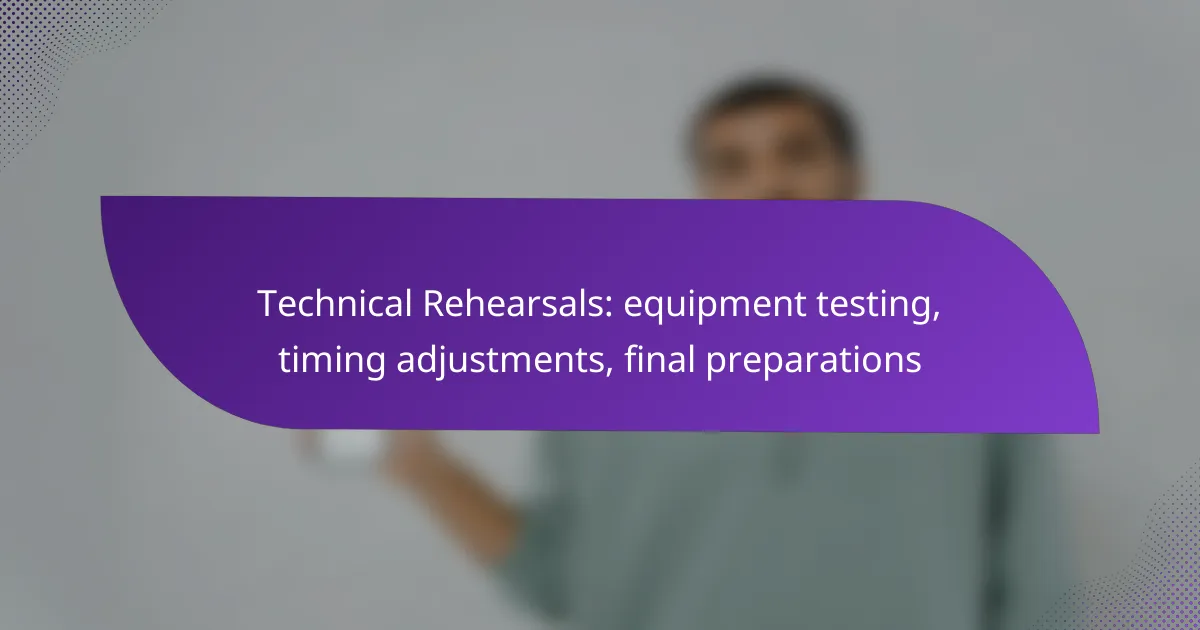Technical rehearsals are vital for ensuring a flawless performance, focusing on equipment testing, timing adjustments, and final preparations. These sessions allow for the identification of potential issues and the refinement of technical elements, including audio, lighting, and video tools. By meticulously adjusting timing and monitoring cues, production teams can achieve seamless transitions and enhance the overall quality of the show.

How to conduct effective technical rehearsals?
Effective technical rehearsals involve thorough equipment testing, precise timing adjustments, and final preparations to ensure a seamless performance. These rehearsals are critical for identifying potential issues and refining the technical aspects of a production.
Step-by-step rehearsal process
The rehearsal process begins with a detailed run-through of the entire production, focusing on technical elements like lighting, sound, and set changes. It is essential to schedule multiple rehearsals, allowing time for adjustments based on initial findings.
During each rehearsal, document any issues that arise and prioritize them for resolution. Use a checklist to track equipment functionality, cue timings, and any required adjustments, ensuring that all team members are on the same page.
Key roles in technical rehearsals
Several key roles contribute to the success of technical rehearsals. The director oversees the overall vision and ensures that technical elements align with the artistic intent. The stage manager coordinates logistics and communication among the crew.
Additionally, technicians for sound, lighting, and set design play crucial roles in executing their respective responsibilities. Each team member should be familiar with their tasks and ready to adapt as needed during rehearsals.
Common rehearsal pitfalls
One common pitfall is inadequate time allocation for technical rehearsals, which can lead to rushed adjustments and unresolved issues. Ensure that rehearsals are scheduled well in advance and allow for flexibility in timing.
Another issue is poor communication among team members, which can result in confusion and mistakes during the performance. Establish clear communication protocols and encourage open dialogue to address concerns promptly.

What equipment is essential for technical rehearsals?
Essential equipment for technical rehearsals includes audio, lighting, and video tools that ensure a seamless performance. Proper testing and adjustments of this equipment are crucial for achieving the desired production quality.
Audio equipment requirements
Audio equipment is vital for delivering clear sound during a performance. Key components include microphones, speakers, mixers, and audio interfaces. Ensure that microphones are suitable for the venue size and type of performance, as well as testing speaker placement for optimal sound distribution.
When selecting audio equipment, consider the acoustics of the space. For larger venues, you may need multiple speakers and a more complex mixing setup. Always conduct sound checks to identify any issues with feedback or volume levels before the rehearsal begins.
Lighting setup essentials
Lighting is crucial for setting the mood and visibility during a performance. Essential lighting equipment includes spotlights, floodlights, and dimmers. It’s important to plan the lighting design in advance, considering how different colors and intensities will affect the scene.
During technical rehearsals, test each lighting fixture to ensure proper functionality and adjust angles and brightness as needed. Be mindful of shadows and glares that could distract the audience. A checklist can help ensure all lights are accounted for and functioning correctly.
Video and projection tools
Video and projection tools enhance storytelling through visual elements. Essential equipment includes projectors, screens, and video cameras. When integrating video into a performance, ensure that the resolution and brightness are adequate for the venue’s lighting conditions.
During rehearsals, check the alignment and clarity of projections. Test the timing of video cues with live action to avoid any discrepancies. Consider having backup equipment ready in case of technical failures, as this can save critical time during performances.

How to adjust timing during technical rehearsals?
Adjusting timing during technical rehearsals is crucial for ensuring that all elements of a performance synchronize effectively. This involves monitoring cues, making real-time adjustments, and ensuring that transitions between scenes flow smoothly.
Timing adjustment techniques
Effective timing adjustment techniques include using a stopwatch or digital timer to track cue timings and rehearsing transitions multiple times to identify any discrepancies. Consider employing a metronome to maintain a consistent pace, especially in musical performances.
Another technique is to create a timing sheet that outlines each cue’s timing, allowing for quick reference during rehearsals. This helps in identifying which cues need adjustments and ensures everyone is on the same page.
Tools for timing analysis
Tools for timing analysis can range from simple stopwatches to advanced software designed for live performances. Digital audio workstations (DAWs) can be particularly useful, as they allow for precise editing and timing adjustments of audio cues.
Additionally, video recording the rehearsal can provide visual feedback on timing issues. By reviewing the footage, you can pinpoint where adjustments are necessary and how they affect the overall flow of the performance.
Importance of cue timing
Cue timing is essential for maintaining the rhythm and flow of a performance. Properly timed cues ensure that actors, musicians, and technical staff work in harmony, preventing disruptions that can distract the audience.
Inconsistent cue timing can lead to missed lines, awkward pauses, or even technical failures. Therefore, rehearsing with a focus on cue timing helps build confidence and ensures that everyone is prepared for the live performance.

What are the final preparations before a performance?
Final preparations before a performance involve a series of essential tasks to ensure everything runs smoothly. These include equipment testing, timing adjustments, and coordinating team efforts to address any last-minute issues.
Checklist for final preparations
A comprehensive checklist is crucial for final preparations. Key items typically include verifying equipment functionality, confirming the schedule, and ensuring all team members understand their roles. Here’s a basic checklist:
- Test all audio and visual equipment
- Confirm the performance schedule
- Review safety protocols
- Conduct a final run-through
Last-minute equipment checks
Last-minute equipment checks are vital to avoid technical failures during the performance. This includes testing microphones, lighting, and any other technical gear to ensure they are functioning correctly. Aim to complete these checks at least 30 minutes before the show starts.
Consider having a dedicated technician for each major piece of equipment. This allows for quick troubleshooting and adjustments, minimizing potential disruptions.
Team communication strategies
Effective communication among team members is essential during final preparations. Establish clear channels, such as walkie-talkies or group messaging apps, to facilitate real-time updates and coordination. Regular briefings can help ensure everyone is on the same page.
Encourage an open environment where team members can voice concerns or suggest adjustments. This proactive approach can help identify issues before they escalate, ensuring a smoother performance.

What are the best practices for equipment testing?
Best practices for equipment testing involve systematic procedures to ensure reliability and performance before deployment. This includes regular checks, adherence to protocols, and thorough documentation to identify and rectify any issues early in the process.
Routine testing schedules
Establishing routine testing schedules is crucial for maintaining equipment performance. Regular intervals, such as weekly or monthly checks, help identify potential failures before they occur. For critical systems, daily checks may be warranted, especially in high-stakes environments like broadcasting or live events.
Consider creating a calendar that outlines specific testing dates and responsibilities. This not only ensures accountability but also helps in tracking the history of equipment performance over time.
Testing protocols for reliability
Implementing testing protocols enhances reliability by standardizing procedures for equipment checks. These protocols should include steps for functional testing, stress testing, and safety checks. For example, audio equipment may require tests for sound quality, distortion levels, and connectivity.
Documentation of test results is essential for future reference and compliance with industry standards. Regularly review and update protocols to incorporate new technologies or feedback from previous tests, ensuring continuous improvement in testing practices.
